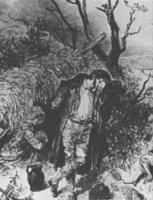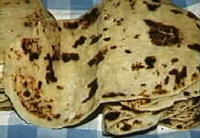Poor Man's Gold
 Yesterday I dug my last bucket of potatoes. Now there's a very large pile of them on the floor in my basement under an old sheet.
Yesterday I dug my last bucket of potatoes. Now there's a very large pile of them on the floor in my basement under an old sheet.They are a little tricky to handle for storage. You have to let them sit spread out for a couple of weeks before you box or bag them. You can't wash them--washing them straight after digging would destroy those tender skins--but once they harden a bit you can brush the dirt off.
And you don't cold store them like you would carrots or cabbage. Potatoes like it cool, but not cold. They need a constant temperature of 7-10C. Anything colder and they turn on you. Well, they turn very sweet, anyway.
You have to be careful what you store them with, too. Onions and potatoes don't mix, storage-wise. They do nasty things to each other with their gasses. Apples and potatoes don't mix either. The gasses from the apples cause the potatoes to sprout, so unless you want a jungle in your basement, keep your apples somewhere else.
Does this sound like a whole lot of trouble to go through for a bunch of potatoes? You only think that because you don't know how valuable potatoes really are. As Judy said in the comments to my other potato post, there's nothing like a lovely pile of potatoes to make someone feel filthy rich.
That's why digging them is so much fun. Each potato is like a little golden gem hidden beneath the soil. You see just the flash of yellow skin, and you must dig for the rest. Will it be just another one of those little guys, or will this one be a baker? Or maybe....just maybe....it will be too big for baking. Maybe it will be the sort of potato that mythical potato stories are made of!
I've already heard my neighbor's big potato story for the year. He had one the size of a football. Or so he says. I think it was probably the size of his dog's toy football. I had a football-sized one, too, or maybe bigger, but I accidently cut it in half with the shovel, so I can't prove it to you.
Are you still unconvinced about the true value of the lowly potato? What if I told you that ever since the Spanish raided the Incas and discovered Incan truffles, potatoes have been the stuff wars are made of? Don't you know that the only reason the Irish survived all those wars in the 1600's is because when the various enemies destroyed all the other food sources, they missed those precious underground tubers?
During the Second World War, the Russians kept some seed potatoes under 24 hour guard because they considered potatoes vital to their success in the war. Without potatoes, they believed, they would be defeated. One war is even called The Potato War, because the primary war strategy for the armies from Prussia and Austria was to steal each other's potatoes. When the potatoes were gone, the war ended.
We tend to think of potatoes as empty calories, but we couldn't be more mistaken. Potatoes, eaten with the skin, provide so many nutrients that if you had a milk cow and potatoes, you'd be perfectly set to feed yourself. Your diet might be a tad boring, but you'd be healthy.
 And lack of potatoes is not a good thing. Remember the Irish Potato Famine? A blight on potatoes wiped out the potato crop for three years--1845, 1846, and 1848. One million people died of starvation and disease. Mr. O'Conner, my Sociology 101 teacher way back in my university days, was convinced that the reason for his own stocky build was that his ancestors were famine survivors. They were of the sort, genetically, that required little food to live, and that was an advantage when it came to surviving without potatoes. Those who were naturally thin were in much bigger trouble without their potatoes.
And lack of potatoes is not a good thing. Remember the Irish Potato Famine? A blight on potatoes wiped out the potato crop for three years--1845, 1846, and 1848. One million people died of starvation and disease. Mr. O'Conner, my Sociology 101 teacher way back in my university days, was convinced that the reason for his own stocky build was that his ancestors were famine survivors. They were of the sort, genetically, that required little food to live, and that was an advantage when it came to surviving without potatoes. Those who were naturally thin were in much bigger trouble without their potatoes.Even our artwork reflects the importance of potatoes. The painting at the beginning of this post is by Van Gogh. It's called The Potato Eaters. Van Gogh liked painting potato related things. There's Peasant Woman Digging Up Potatoes and Peasant Woman Peeling Potatoes, along with Peasants Lifting Potatoes. Peasants and potatoes; spuds are the poor man's gold.
 Millet's Angelus is about potatoes, too. Along with thanking God for the supper she's brought, I bet those two are thanking him for the potatoes, because that's what he's been digging out there in the field. Yes, they are indeed Incan truffles under the soil. I'm thankful for my pile in the basement, and I'll be thankful all winter as we eat them.
Millet's Angelus is about potatoes, too. Along with thanking God for the supper she's brought, I bet those two are thanking him for the potatoes, because that's what he's been digging out there in the field. Yes, they are indeed Incan truffles under the soil. I'm thankful for my pile in the basement, and I'll be thankful all winter as we eat them.And eat them, we will. Served almost every way possible. One of our favorite ways is plain old riced, with butter and pepper. We like them baked, too. If you put cheese sauce with broccoli on top of your baked potato, you've got a whole meal.
Potato salad is a big deal in this house--the sort made with hard boiled eggs, potatoes, onions and mayonaise. You must mash the egg yolks, though, and put them in the mayonaise along with a little mustard. This gives the salad a beautiful yellow color. The secret ingredient, however, is dill pickle juice. Really. Mix a generous amount in the mayonaise mixture and see if that doesn't give the salad just the right tang. If I had a recipe, I'd share it, but this is one of my "wing it" dishes.
Potato soup? I make mine like the good old Scandanavian potato soup served at the school cafeteria when I was in elementary school. Just like this. For potato rolls, I use Edna Ruth Byler's recipe from the More-With-Less Cookbook. The big advantage to this recipe is that it can be stored in the fridge for three days, and will make raised doughnuts, jelly doughnuts, cinnamon buns and dinner rolls, all from one big batch if you want.
 And this year, I'm thinking about getting a lefse grill. Unfortunately, I don't live in Minnesota where you can buy lefse in the deli section of your supermarket, so I'm going to oufit myself to make my own. I know that lutefisk gives Norwegian cooking a bad name, but there's absolutely nothing better than cold fresh lefse spread with butter, sprinkled with white sugar and rolled into a tasty little bundle.
And this year, I'm thinking about getting a lefse grill. Unfortunately, I don't live in Minnesota where you can buy lefse in the deli section of your supermarket, so I'm going to oufit myself to make my own. I know that lutefisk gives Norwegian cooking a bad name, but there's absolutely nothing better than cold fresh lefse spread with butter, sprinkled with white sugar and rolled into a tasty little bundle.Right now, though, I'm going down to the basement to admire my stash and be thankful for it.








<< Home